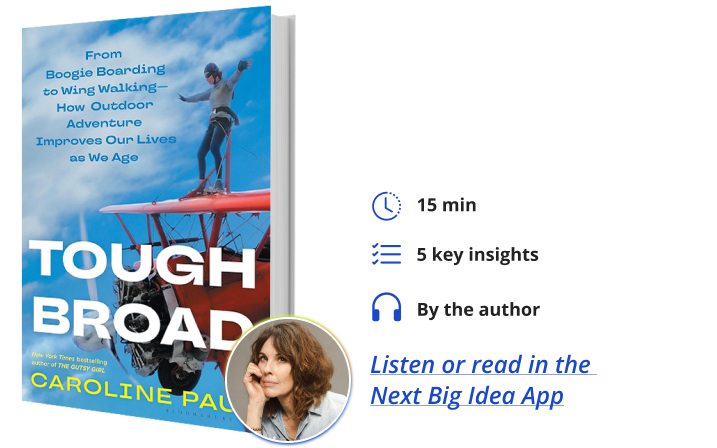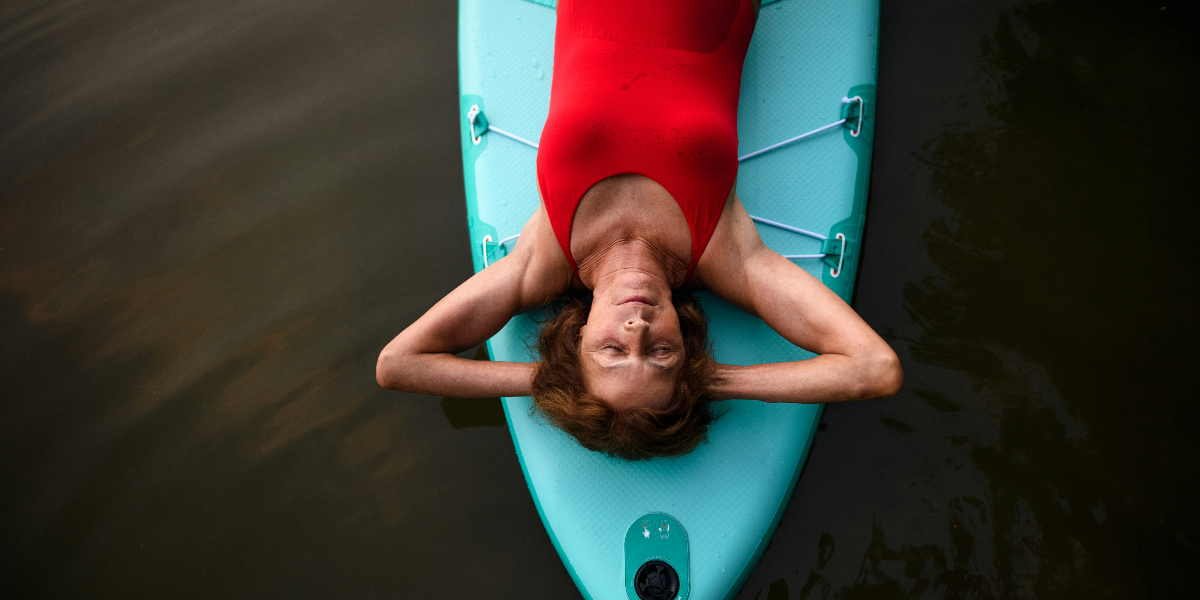Caroline Paul is a New York Times bestselling author of The Gutsy Girl: Escapades for Your Life of Epic Adventure; You Are Mighty: A Guide to Changing the World; and Lost Cat: A True Story of Love, Desperation, and GPS Technology, as well as the memoir Fighting Fire about becoming one of the first female firefighters in San Francisco, and the novel East Wind, Rain. She graduated with a Communication degree from Stanford University and is part of the San Francisco Writers Grotto.
Below, Caroline shares five key insights from her new book, Tough Broad: From Boogie Boarding to Wing Walking―How Outdoor Adventure Improves Our Lives as We Age. Listen to the audio version—read by Caroline herself—in the Next Big Idea App.

1. The way we look at our own aging predicts how well we will age.
One day, when I was surfing in a cold winter swell, looking around, there were no middle-aged women out there. There were lots of middle-aged men, some as old as 75, but no women. You see the same thing if you look around at people skateboarding or even flying—plenty of middle-aged men and older, but no women.
So why aren’t they out there? Turns out the messaging around aging for women in this country is really toxic. Women are told that this will be a time of breaking bones and cognitive decline and fading attractiveness—being boring. The uncertainty of the outdoors is way too much for us, we’re told, and the rest is a white knuckle ride through illness and cultural irrelevance.
But really, it’s all in the mindset. Studies show that the way we look at our own aging predicts how well we age. This means that if you think aging is going to be a time of frailty and diminution, you have a significantly higher chance of cardiac issues and earlier cognitive decline. However, if you see your aging journey as full of exhilaration and exploration, you will be healthier and happier. What’s mind-blowing is that women, with the right mindset, can live seven and a half years longer.
2. The outdoors is the single best antidote against toxic ageism.
Science is telling us that we need a positive mindset about our own aging, but what they don’t say is how you get that mindset in the face of such terribly depressing messaging. A mantra and positive thinking are not really going to do it.
A group of 60, 70, 80, and even 90-year-olds in San Diego called ‘Water with the Wave Chasers’ do a lot of boogie boarding together. Boogie boarding is a simple sport: you wade out in the water, maybe wearing fins, holding a flotation square, and ride a wave or even just the whitewater of a wave as it takes you back to shore.
Boogie boarding is typically a sport for kids. Lorraine Voight says that boogie boarding changed her life. It gives me goosebumps to hear her explanation, “I’ve never been an outdoor person. I’ve never had an outdoor life. And look, here I am in this vast Pacific Ocean getting tumbled by the water. I come three times a week because I’m committed to this group. However cold the water is, or however windy it can be, I am here. I’m 62 years old, and I am in it.”
“They are upending what society thinks they can and cannot do.”
Boogie boarding, and outdoor adventuring in general, is a direct rebuke to all the messaging that told Lorraine—and so many others—that as an older woman, she was frail, no longer sharp, no longer fun, but boring. When Lorraine and the other group members get into the water, what they are doing is more than boogie boarding, they are upending what society thinks they can and cannot do.
What nature asks of us when we engage with her really puts a lie to all that we’re told about our aging journey. This is how we deeply embody that positive mindset scientists tell us is vital to our health and future; an outdoor activity of exhilaration, exploration, and physical vitality.
3. Cultivate awe because it’s really good for you.
Awe is defined as the emotion we feel in the presence of something mysterious, something bigger than ourselves, a sort of fear, confusion and wonder all mixed up. It is often associated with a religious experience, but it’s also easily triggered by nature: looking up at the night sky or down into the vast Grand Canyon. Science tells us awe is really good for us.
I found awe when I went wing walking, which is when you climb out of a perfectly good biplane cockpit while 3000 feet in the air and walk to the center of the wing. In my case, it wasn’t wing walking, it was more wing slithering and wing crawling. Then, once I strapped myself into the king post in the center on the top of the wing, the pilot executed a series of loops, hammerheads, and barrel rolls, and my brain was immediately jettisoned into awe.
Luckily, you don’t have to find awe by wing walking; you can access it by simply walking. Scientists from the UCSF Memory Care and Aging Institute sent volunteers between the ages of 60 and 80 on a 15-minute-daily outdoor amble every day over an eight-week period. The instruction they gave them was to look at everything with fresh, childlike eyes, thus cultivating awe in the people who were walking. Almost as an afterthought, the researchers asked participants to take a selfie during each excursion. These walkers, as they were called, soon reported an uptick in well-being, a decrease in anxiety, and more gratitude and compassion. Scientists also found significantly lower inflammation, another key to good health.
Most notably, those selfies, which initially featured the walker’s face on the whole screen, began to change over the course of eight weeks. The faces began receding, and the surroundings began to take up most of the photo instead. The scientists called this a small-self perspective, suggesting that the participants have become more curious and have a much healthier sense of their place.
In the wider world, scientists call awe a reset button for the brain because it kind of shakes up our neural patterns and makes us more open-minded. It’s also worth noting that we live in a world of anti-awe devices, like our phones and computers. Those screens narrow our focus, ask us to think small, center us, and make us feel powerful and in control. That’s the opposite of awe. The upshot is by slowing down and allowing yourself to marvel at leaves, tree bark, insects, or birds, you too can uncenter yourself, reset some old neural pathways, lower your cortisol and your inflammation, and really make way for novel thoughts and deeper emotion like gratitude and compassion. You can even try wing walking if your spirit moves you.
4. Mother nature is medicinal.
I knew on an intuitive level that I felt better after getting outside, but it turns out there is some real biological evidence for this. Things like the chemicals in trees strengthen our immune system and lower blood pressure. Studies on bird songs show it elevates both our mood and our cognitive ability. Scientists think the sound of happy preening birds signals to our primitive self that no predators are about. When birds go quiet, as in urban environments, our nervous system really fires up, ready to fight or fight for whatever’s hiding in the bushes.
“15 to 45 minutes in a natural setting of any sort increases well-being.”
Also, the rounded shapes in nature, like the horizons and hills, along with the repeating fractal elements of things like trees and leaves, match well with how our retina is built, allowing us ease in processing when we’re outside. The brain, which constantly filters stimuli, has less noise and busy work to deal with. Compare that to what it has to do in an urban setting with the racing traffic, the sudden loud noises, and the hard linear architecture—going outside is restful for the brain. This is why people who take a walk in green spaces showed significant improvement in memory and cognition when they were tested afterward. In conclusion, 15 to 45 minutes in a natural setting of any sort increases well-being. Five hours a month is a prescription for ongoing emotional and physical restoration.
People say they feel a lot of fear about picking up an outdoor activity, and they’re reluctant. But we all take pharmaceuticals when they promise to improve our health, even though they have a long list of possible side effects: vomiting, diarrhea, and headaches. If we think of the trepidation that we might feel about going outside as just another side effect, it will, in fact, lead to not just better physical health but better emotional health, an overall well-being that is really hard to beat.
5. We can, and must, learn something new at an older age.
One of our biggest concerns as we age is cognitive health. One of the best ways to keep your brain firing is novelty or learning something new. When was the last time you learned something new? Recently, we seemed only to learn to stand six feet from someone when the pandemic hit. We’re taught to believe that our brains are too calcified to be tasked with new challenges as we age. However, research proves that the brain has what we call plasticity, and it’s constantly making new cells no matter how old we are. The outdoors is a great place to bring novelty into your life, mostly because mother nature is always uncertain.
For instance, if you go for a walk in the park, it might rain, or you might see a bird you didn’t expect. It’s wildly novel out there, and your brain has to adapt. When I learned to fly a gyrocopter, I noticed that I learned to fly it better than I would have as a younger version of myself. I learned about this strange flying machine without all the insecurities, the need to be liked, or the need to prove something I had as a younger person.
Vijaya Riva Staava’s doctor told her that at 68, she really needed to exercise and prescribed her swimming lessons. However, Vijaya said she had never had an outdoor lifestyle, not even a walking practice. The only thing she’d done that was even remotely active was badminton. When the doctor prescribed swimming, Vijaya explained that she was afraid of drowning, even though she is known to have a really adventurous spirit. Instead of ignoring her doctor’s advice, she enlisted a friend and began learning to swim. Every lesson she took was a challenge, not just for her brain but also for her sense of self. She kept upending what she thought she could and could not do during the process. She discovered that once she began swimming, she felt capable of anything. She began picking up other activities, not just outdoor activities, and her whole life opened up.
Older people today will tell you that the best decade is your 60’s. Not the sexy, dewy 20’s, the striving 30’s, or the family-oriented 40’s, but the 60’s. Unfortunately, that is not what society is telling us.
To listen to the audio version read by author Caroline Paul, download the Next Big Idea App today:































